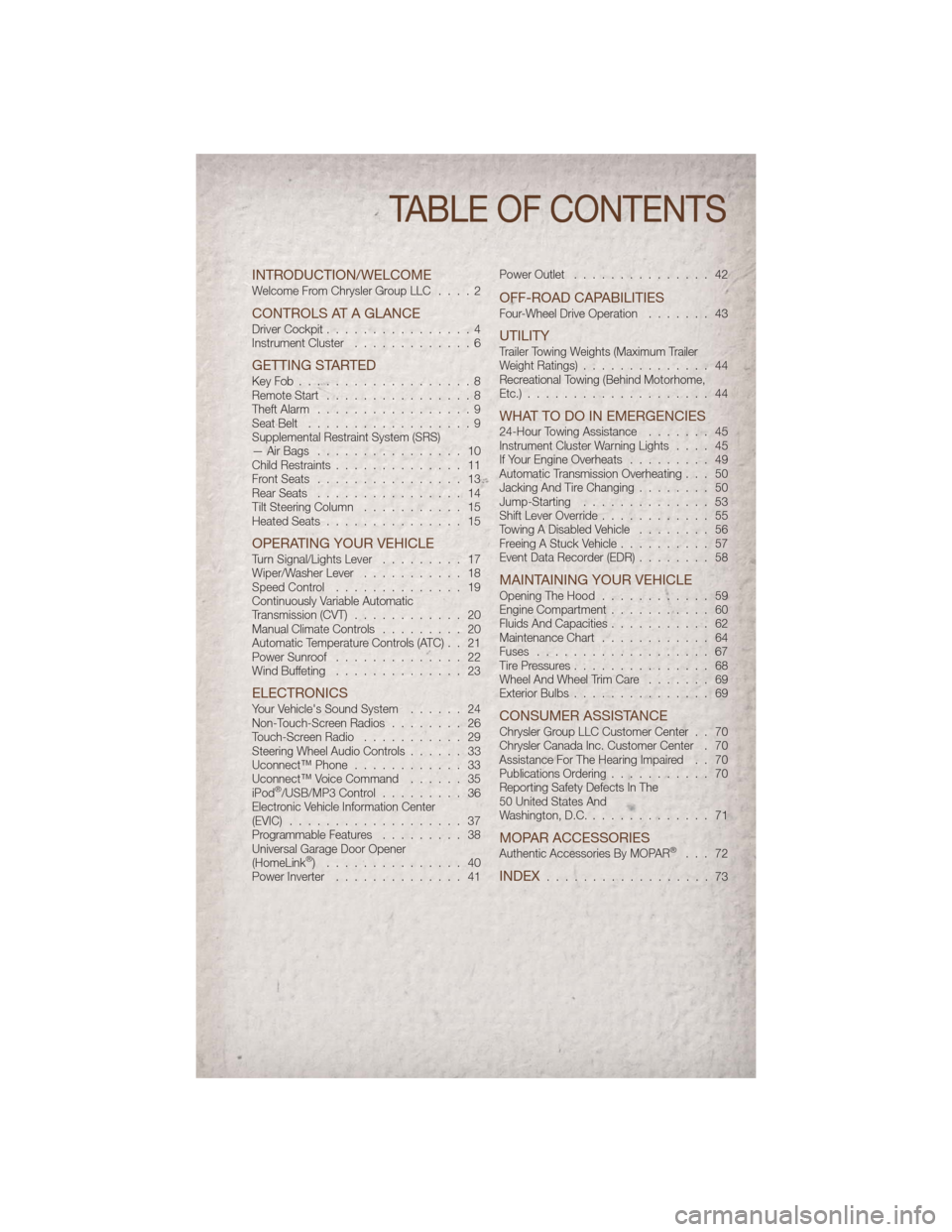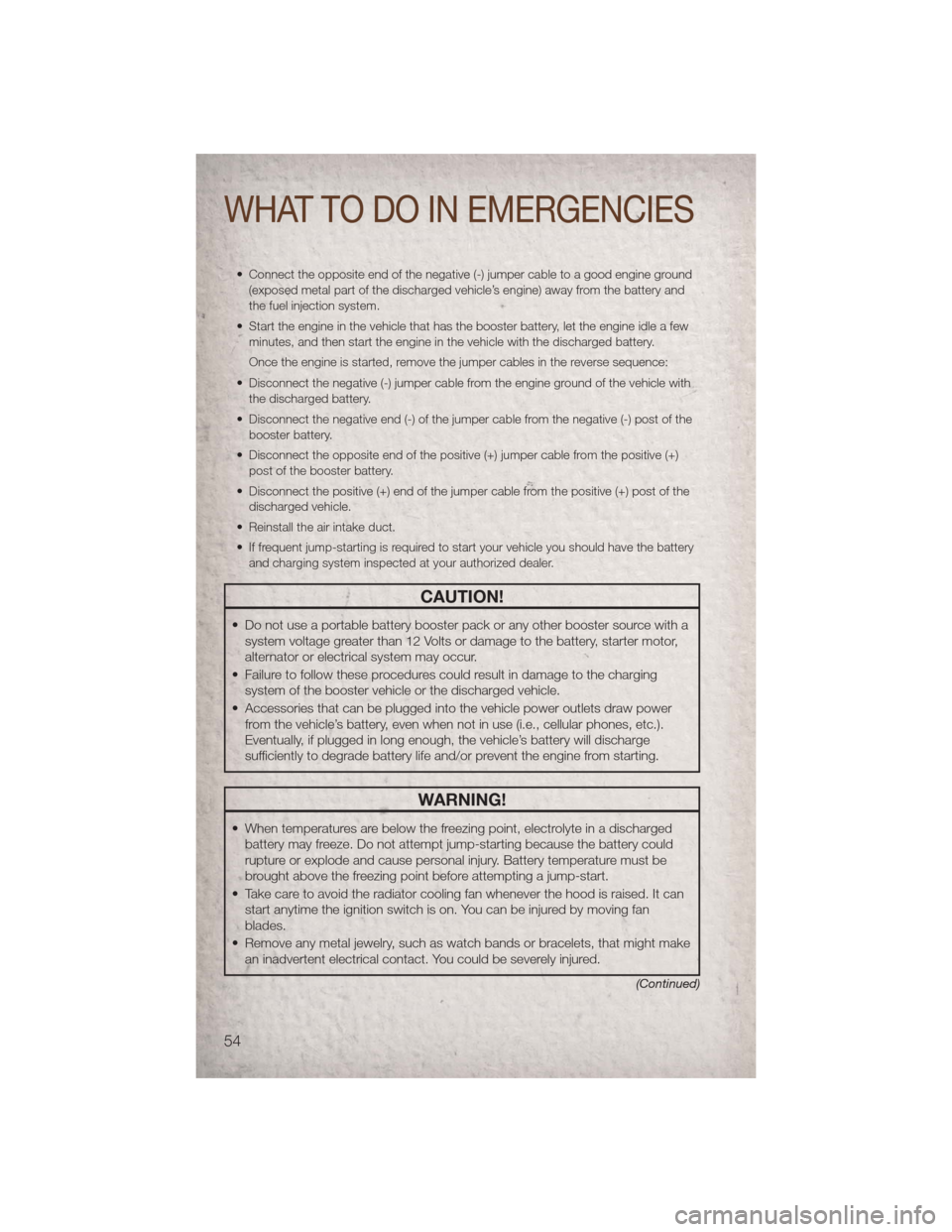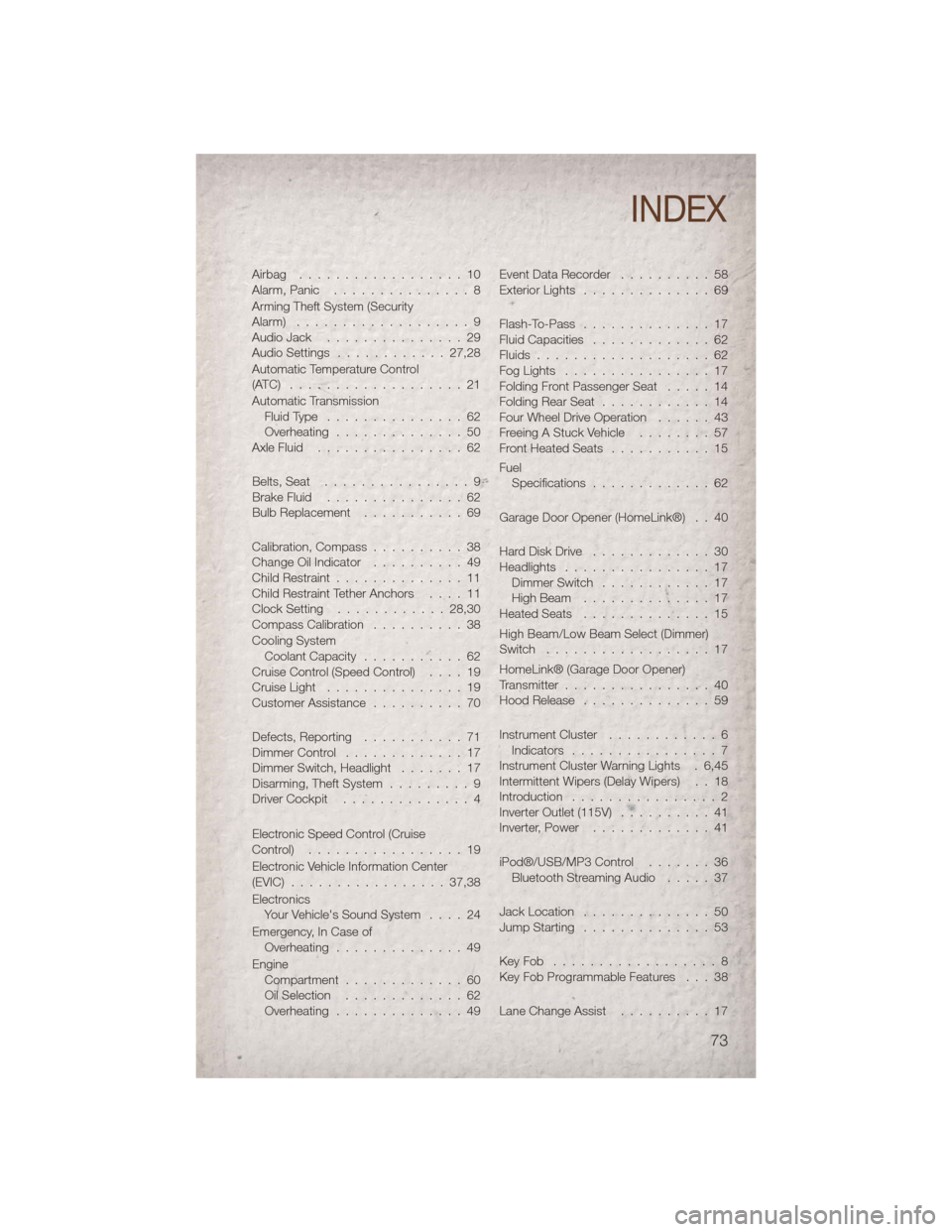jump start JEEP COMPASS 2011 1.G User Guide
[x] Cancel search | Manufacturer: JEEP, Model Year: 2011, Model line: COMPASS, Model: JEEP COMPASS 2011 1.GPages: 80, PDF Size: 3.09 MB
Page 3 of 80

INTRODUCTION/WELCOMEWelcome From Chrysler Group LLC....2
CONTROLS AT A GLANCEDriver Cockpit................4
Instrument Cluster .............6
GETTING STARTEDKeyFob...................8
Remote Start................8
Theft Alarm .................9
Seat Belt ..................9
Supplemental Restraint System (SRS)
— Air Bags ................ 10
Child Restraints .............. 11
Front Seats ................ 13
Rear Seats ................ 14
Tilt Steering Column ........... 15
Heated Seats ............... 15
OPERATING YOUR VEHICLETurn Signal/Lights Lever ......... 17
Wiper/Washer Lever ........... 18
Speed Control .............. 19
Continuously Variable Automatic
Transmission (CVT) ............ 20
Manual Climate Controls ......... 20
Automatic Temperature Controls (ATC) . . 21
Power Sunroof .............. 22
Wind Buffeting .............. 23
ELECTRONICSYour Vehicle's Sound System ...... 24
Non-Touch-Screen Radios ........ 26
Touch-Screen Radio ........... 29
Steering Wheel Audio Controls ...... 33
Uconnect™ Phone ............ 33
Uconnect™ Voice Command ...... 35
iPod
®/USB/MP3 Control ......... 36
Electronic Vehicle Information Center
(EVIC) ................... 37
Programmable Features ......... 38
Universal Garage Door Opener
(HomeLink
®) ............... 40
Power Inverter .............. 41 Power Outlet
............... 42
OFF-ROAD CAPABILITIESFour-Wheel Drive Operation ....... 43
UTILITYTrailer Towing Weights (Maximum Trailer
Weight Ratings).............. 44
Recreational Towing (Behind Motorhome,
Etc.) .................... 44
WHAT TO DO IN EMERGENCIES24-Hour Towing Assistance ....... 45
Instrument Cluster Warning Lights .... 45
If Your Engine Overheats ......... 49
Automatic Transmission Overheating . . . 50
Jacking And Tire Changing ........ 50
Jump-Starting .............. 53
Shift Lever Override ............ 55
Towing A Disabled Vehicle ........ 56
Freeing A Stuck Vehicle .......... 57
Event Data Recorder (EDR) ........ 58
MAINTAINING YOUR VEHICLEOpening The Hood............ 59
Engine Compartment ........... 60
Fluids And Capacities ........... 62
Maintenance Chart ............ 64
Fuses ................... 67
Tire Pressures ............... 68
Wheel And Wheel Trim Care ....... 69
Exterior Bulbs ............... 69
CONSUMER ASSISTANCEChrysler Group LLC Customer Center . . 70
Chrysler Canada Inc. Customer Center . 70
Assistance For The Hearing Impaired . . 70
Publications Ordering ........... 70
Reporting Safety Defects In The
50 United States And
Washington, D.C. ............. 71
MOPAR ACCESSORIESAuthentic Accessories By MOPAR®... 72
INDEX.................. 73
TABLE OF CONTENTS
Page 55 of 80

JUMP-STARTING
• If your vehicle has a discharged battery it can be jumpstarted using a set of jumpercables and a battery in another vehicle or by using a portable battery booster pack.
• Jump-starting can be dangerous if done improperly so please follow the procedures in this section carefully.
NOTE: When using a portable battery booster pack follow the manufacturer’s operating
instructions and precautions.
Preparations for Jump-Start
• The battery in your vehicle is located in the front of the engine compartment below the air intake duct. To access the battery remove the air intake duct by turning the
two finger screws, located on the radiator support.
• Set the parking brake, shift theautomatic transmission into PARK and
turn the ignition to LOCK.
• Turn off the heater, radio, and all unnecessary electrical accessories.
• If using another vehicle to jump-start the battery, park the vehicle within the
jumper cables reach, set the parking
brake and make sure the ignition is
OFF.
Jump-Starting Procedure
• Connect the positive (+) end of the jumper cable to the positive (+) post of the
discharged vehicle.
• Connect the opposite end of the positive (+) jumper cable to the positive (+) post of the booster battery.
• Connect the negative end (-) of the jumper cable to the negative (-) post of the booster battery.
WHAT TO DO IN EMERGENCIES
53
Page 56 of 80

• Connect the opposite end of the negative (-) jumper cable to a good engine ground(exposed metal part of the discharged vehicle’s engine) away from the battery and
the fuel injection system.
• Start the engine in the vehicle that has the booster battery, let the engine idle a few minutes, and then start the engine in the vehicle with the discharged battery.
Once the engine is started, remove the jumper cables in the reverse sequence:
• Disconnect the negative (-) jumper cable from the engine ground of the vehicle with the discharged battery.
• Disconnect the negative end (-) of the jumper cable from the negative (-) post of the booster battery.
• Disconnect the opposite end of the positive (+) jumper cable from the positive (+) post of the booster battery.
• Disconnect the positive (+) end of the jumper cable from the positive (+) post of the discharged vehicle.
• Reinstall the air intake duct.
• If frequent jump-starting is required to start your vehicle you should have the battery and charging system inspected at your authorized dealer.
CAUTION!
• Do not use a portable battery booster pack or any other booster source with asystem voltage greater than 12 Volts or damage to the battery, starter motor,
alternator or electrical system may occur.
• Failure to follow these procedures could result in damage to the charging system of the booster vehicle or the discharged vehicle.
• Accessories that can be plugged into the vehicle power outlets draw power from the vehicle’s battery, even when not in use (i.e., cellular phones, etc.).
Eventually, if plugged in long enough, the vehicle’s battery will discharge
sufficiently to degrade battery life and/or prevent the engine from starting.
WARNING!
• When temperatures are below the freezing point, electrolyte in a dischargedbattery may freeze. Do not attempt jump-starting because the battery could
rupture or explode and cause personal injury. Battery temperature must be
brought above the freezing point before attempting a jump-start.
• Take care to avoid the radiator cooling fan whenever the hood is raised. It can start anytime the ignition switch is on. You can be injured by moving fan
blades.
• Remove any metal jewelry, such as watch bands or bracelets, that might make an inadvertent electrical contact. You could be severely injured.
(Continued)
WHAT TO DO IN EMERGENCIES
54
Page 75 of 80

Airbag ..................10
Alarm,Panic ...............8
Arming Theft System (Security
Alarm) ...................9
Audio Jack...............29
Audio Settings ............27,28
Automatic Temperature Control
(ATC) ...................21
Automatic Transmission FluidType ...............62
Overheating ..............50
AxleFluid ................62
Belts, Seat ................9
BrakeFluid ...............62
Bulb Replacement ...........69
Calibration, Compass ..........38
Change Oil Indicator ..........49
Child Restraint ..............11
Child Restraint Tether Anchors ....11
Clock Setting ............28,30
Compass Calibration ..........38
Cooling System Coolant Capacity ...........62
Cruise Control (Speed Control) ....19
CruiseLight ...............19
Customer Assistance ..........70
Defects, Reporting ...........71
Dimmer Control .............17
Dimmer Switch, Headlight .......17
Disarming, Theft System .........9
Driver Cockpit ..............4
Electronic Speed Control (Cruise
Control) .................19
Electronic Vehicle Information Center
(EVIC) .................37,38
Electronics Your Vehicle's Sound System ....24
Emergency, In Case of Overheating ..............49
Engine Compartment .............60
OilSelection .............62
Overheating ..............49 Event Data Recorder
..........58
Exterior Lights ..............69
Flash-To-Pass ..............17
Fluid Capacities .............62
Fluids ...................62
FogLights ................17
Folding Front Passenger Seat .....14
Folding Rear Seat ............14
Four Wheel Drive Operation ......43
Freeing A Stuck Vehicle ........57
Front Heated Seats ...........15
Fuel Specifications .............62
Garage Door Opener (HomeLink®) . . 40
Hard Disk Drive .............30
Headlights ................17
Dimmer Switch ............17
High Beam ..............17
HeatedSeats ..............15
High Beam/Low Beam Select (Dimmer)
Switch ..................17
HomeLink® (Garage Door Opener)
Transmitter ................40
Hood Release ..............59
Instrument Cluster ............6
Indicators ................7
Instrument Cluster Warning Lights . 6,45
Intermittent Wipers (Delay Wipers) . . 18
Introduction ................2
Inverter Outlet (115V) ..........41
Inverter
, Power .............41
iPod®/USB/MP3 Control .......36
Bluetooth Streaming Audio .....37
Jack Location ..............50
Jump Starting ..............53
KeyFob ..................8
Key Fob Programmable Features . . . 38
Lane Change Assist ..........17
INDEX
73